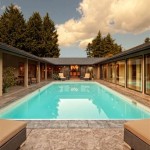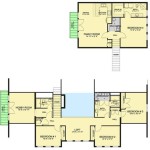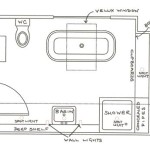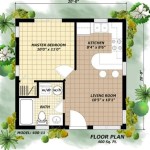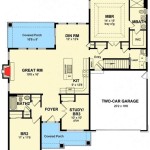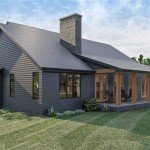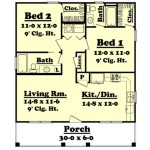House Plans For Multigenerational Families
In an era marked by changing demographics and evolving family dynamics, multigenerational living is experiencing a resurgence. The desire for family connectedness, financial support, and shared caregiving responsibilities drives many families to seek living arrangements that accommodate multiple generations under one roof. As a result, the demand for house plans specifically designed for multigenerational families has soared, offering innovative spaces that cater to the unique needs and preferences of each generation.
Designing a home for a multigenerational family requires careful consideration of various factors, including privacy, accessibility, shared living areas, and individual needs. From independent living suites to flexible spaces that accommodate evolving family dynamics, these house plans prioritize both individual comfort and family unity. This article explores the key features and considerations for designing homes that foster harmonious and fulfilling multigenerational living.
Private Retreats Within a Shared Space
One of the most critical elements in multigenerational living is the balance between shared space and individual privacy. House plans for multigenerational families prioritize the creation of distinct living areas that offer both togetherness and personal space. Separate living suites with their own entrances, bedrooms, bathrooms, and kitchenettes provide a sense of independence and autonomy, while communal areas such as living rooms, dining rooms, and outdoor patios encourage family interaction and shared experiences.
Creating these private retreats within a shared space is not only about physical separation but also about creating distinct spaces that reflect the individual needs and preferences of each generation. For example, a young family might prioritize an open-concept kitchen and living area for their children, while an older generation might prefer a more quiet and secluded living space. Thoughtful planning allows for the creation of personalized spaces within the broader framework of the home, ensuring each generational group feels comfortable and respected.
Accessibility and Universal Design
As families age, accessibility becomes an increasingly important consideration. House plans for multigenerational families should incorporate universal design principles, ensuring that the home is usable and comfortable for individuals of all ages and abilities. This includes features such as:
- Wide doorways and hallways to accommodate wheelchairs and walkers
- No-step entries and ramps for easy access
- Grab bars in bathrooms and showers
- Adjustable countertops and cabinets for optimal reach
- Lever-style door handles for ease of use
By incorporating these design elements, the home becomes a safe and comfortable environment for everyone, promoting independence and mobility for all generations. This forward-thinking approach ensures that the home remains functional and adaptable as family needs evolve over time.
Flexible Spaces for Evolving Dynamics
Multigenerational families are dynamic entities, with changing needs and preferences as time progresses. House plans that anticipate these changes and offer flexible spaces are essential for long-term functionality. This flexibility can be achieved through:
- Multi-purpose rooms that can be adapted for different uses
- Open-concept layouts that allow for easy reconfiguration
- Built-in features such as Murphy beds or convertible furniture that maximize space efficiency
- Outdoor spaces that can serve as extensions of indoor living areas
By designing for adaptability, the house becomes more than a static structure; it becomes a living entity that evolves alongside the family. The flexible spaces create the possibility for a home office one day, a playroom the next, or a guest room when needed. This adaptability allows multigenerational families to adapt to changing family dynamics and create a truly multi-functional living space.
Shared Spaces for Connection and Community
While individual living suites offer privacy, shared living areas are essential for fostering family connection and community. House plans for multigenerational families often feature spacious kitchens, inviting living rooms, and comfortable dining areas designed to encourage shared meals, conversations, and family celebrations. These spaces become the heart of the home, where generations can gather, share stories, and build lasting bonds.
Outdoor living areas also play a crucial role in fostering family togetherness. Patios, balconies, and gardens provide opportunities for shared relaxation, outdoor dining, and play. The addition of a fire pit, a grill, or a swing set can create a welcoming space for generations to come together and enjoy the outdoors. These shared spaces not only enhance the quality of family life but also promote intergenerational connection and create a sense of belonging for each family member.
Designing a home for a multigenerational family requires careful planning and thoughtful consideration of the unique needs and preferences of each generation. By incorporating features that promote privacy, accessibility, flexibility, and shared living spaces, these houses create harmonious and fulfilling living environments where families can thrive. As multigenerational living continues to gain popularity, the designs and features of these homes will continue to evolve, offering innovative solutions for families seeking a fulfilling and interconnected lifestyle.

Fun Functional Multigenerational House Plans Houseplans Blog Com

Best Multigenerational Homes Four Generations One Roof House Plans New Next Gen

Multigenerational Floor Plans Are Perfect For Extended Households

How To Build The Perfect Multi Generational Home Plans Included Oberer Homes

Multi Generational Homes Finding A Home For The Whole Family

Best Multi Generational House Plans And Dual Living Floor

What Is A Multigenerational Home K Hovnanian Homes

Multi Gen Homes D R Horton

Multigenerational Living Is It Right For You Wisdom Homes

What Are Multi Generational Homes And How To Find The Best In Dayton Oberer


